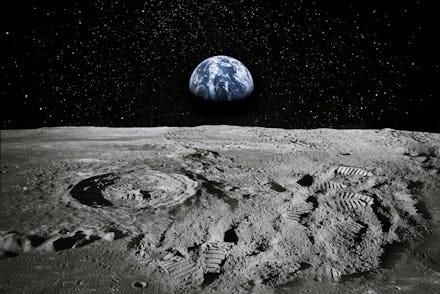The secrets of life on Earth could lie within this mountain on the moon

Humanity may have existed on Earth for an estimated 3.5 billion years, but scientists are still trying to unlock the secrets of life itself. The parts that are still murky revolve around exactly how living beings first emerged and why, especially as Earth is the only confirmed place in our universe where life currently exists – that we know of. Now, we may be on the precipice of uncovering some important secrets about the origin of life itself, if information from a recent study regarding the Moon is to be believed.
The study, published in the journal JGR Planets, posits that a trip completed either by a robotic or human sojourner to the 250-meter-high peak of a basin called Mare Crisium could help fit the puzzle pieces of the first few billion years on Earth together. The findings gleaned from said trip could even help scientists understand important details about humanity's humble beginnings.
Researchers believe that, during the dawn of humanity, both the Earth and the Moon were under a constant barrage of celestial objects such as asteroids and various items in space. This was a period colloquially known as the Late Heavy Bombardment. Both the Earth and Moon were damaged by the same objects over and over, which in turn created the aforementioned basin called Mare Crisium. It's a massive 345 miles in diameter and located in the Moon's northern hemisphere.
But while the Moon remains largely unchanged since then, Earth's continued processes like the presence of oceans and the planet's shifting plates have effectively "reset" our home world's terrain as we know it. So any sort of craters or the like haven't been preserved the way they have with Mare Crisium.
"On the Earth, the record of these impact craters isn’t well-preserved," said study author Dan Moriarty, a NASA Postdoctoral Program fellow at Goddard Space Flight Center, speaking to VICE. "So, we go to the Moon to figure that out."
Using context clues such as the time period Mare Crisium could have been formed years ago, scientists can gauge roughly when the period of heavy bombardment began and additional details that could fill us in on exactly how viable Earth was as a habitable planet back then. For instance, it's totally possible that a lengthy period of space objects smashing into Earth could have resulted in a fiery magma planet that certainly wouldn't have been fit for humans to live on.
"With Crisium, we’ll be able to get a really good sense of when the bulk of the impacts were happening," said study author Moriarty. "If the bulk was really early, that might tell us that the impacts were kind of bunched up in time, whereas if it’s a little later, that tells us that they might have been spread-out impacts that extended a little bit more into the time when life got started on Earth."
Figuring out an exact age for Mare Crisium could unlock important secrets about Earth and how it came to be in the first place, and as such scientists are continuing their research of both the basin and rocks found inside. The mountain peaks there are more similar to the Appalachian Mountain than of the Rocky Mountains, according to Moriarty, meaning it would be simpler for a robotic rover to traverse, or even astronauts if we were to send a team.
Dating Mare Crisium may even end up offering additional information about Earth's infancy beyond what even fossils can provide from billions of years ago. Ironically enough, to learn more about our home world, we've got to go the Moon and back. But it may very well be a mission worth undertaking, especially if we want to get any closer to unraveling the mysteries of life.